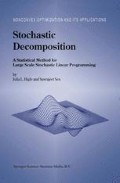Abstract
We are faced with the task of solving two stage stochastic linear programs with recourse (SLP), such as those discussed in Chapter 1. As noted in Theorem 1.1, this class of problems are convex programs and in principle, any of a number of convex programming algorithms (e.g. subgradient methods, cutting plane methods, Lagrangian based methods etc..) can be used to solve SLPs. From the discussions in Chapter 1, it is clear that in most cases, the stochastic nature of the problem precludes the precise determination of subgradients and objective function values. When the presence of random variables prevents the precise determination of such quantities, it is natural to use random samples in the development of statistical estimates of these quantities. Until recently, only subgradient methods were incorporated within a sampling framework, and the resulting methods became known as stochastic quasi-gradient (SQG) methods (see Er-moliev [1988] for a survey). While SQG methods are applicable to very general stochastic convex programs, they suffer from many of the drawbacks of deterministic subgradient methods. In particular, the choice of effective steplengths is often problem dependent. In addition, the incorporation of optimality criteria within these algorithms remains elusive. Nevertheless, because of the incorporation of sampling within the algorithm, SQG methods are able to address SLPs with a large number of outcomes, as well as problems with continous random variables. In developing the Stochastic Decomposition (SD) method, our goal is to bestow these advantages on cutting plane algorithms, which have remained the mainstay for SLPs for several decades (Van Slyke and Wets [1969], Ruszczyński [1986], Birge and Louveaux [1988], Gassmann [1990] etc). The randomization of cutting plane methods has provided the capability of solving truly large scale stochastic programs such as SSN and STORM presented in Chapter 1.
Access this chapter
Tax calculation will be finalised at checkout
Purchases are for personal use only
Preview
Unable to display preview. Download preview PDF.
References
Birge, J.B. and F. Louveaux [1988], A multi-cut algorithm for two stage linear programs, European Journal of Operational Research , 34, pp. 384–392.
Bratley, P., B.L. Fox and L.E. Schrage [1987], A Guide to Simulation, Springer-Verlag, NY.
Dantzig, G.B. and P.W. Glynn [1990], Parallel processors for planning under uncertainty, Annals of Operations Research, 22, pp. 1–21.
Ermoliev, Y. [1988], Stochastic quasigradient methods, in: Numerical Techniques for Stochastic Optimization, Y. Ermoliev and R.J-B. Wets (eds.), Springer Verlag, Berlin.
Gartska, S. and I. Rutenberg [1973], Computation in discrete stochastic programs with recourse, Operations Research, 21, pp. 112–122.
Gassmann, H.I. [1990], MSLiP: A computer code for the multistage stochastic linear programming problem, Mathematical Programming, 47, pp. 407–423.
Haughland, D. and S.W. Wallace [1988], Solving many linear programs that differ only in the right hand side, European Journal of Operational Research , 37, pp. 318–324.
Infanger, G. [1993], Monte Carlo (importance) sampling within a Benders’ decomposition for stochastic linear programs, Annals of Operations Research , 39, pp. 69–95.
Infanger, G. [1994], Planning under Uncertainty — Solving Large-Scale Stochastic Linear Programs, The Scientific Press Series, boyd & fraser.
Kelley, J.E. [1960], The cutting plane method for convex programs, Journal of SIAM, 8, pp. 703–712.
King, A.J. and R.J-B. Wets [1989], Epi-consistency of convex stochastic programs, Stochastics and Statistics Reports, 34, pp. 83–92.
Kiwiel, K.C. [1985], Methods of Descent for Nondifferentiable Optimization, Lecture notes in mathematics no. 1133, Springer-Verlag, Berlin.
Robbins, H. and S. Monro [1951], On a stochastic approximation method, Annals of Math. Stat., 22, pp. 400–407.
Römisch, W. and R. Schultz [1991], Distribution sensitivity in stochastic programming, Mathematical Programming 50, pp. 197–226.
Ruszczyǹski, A. [1986], A regularized decomposition method for minimizing a sum of polyhedral functions, Mathematical Programming, 35, pp. 309–333.
Shapiro, A. [1992], Quantitative Stability in Stochastic Programming, Tech. Report, School of Industrial and Systems Engineering, Georgia Institute of Technology, Atlanta, Georgia 30332–0205.
Van Slyke, R. and R. J-B. Wets [1969], L-Shaped linear programs with application to optimal control and stochastic programming, SIAM Journal on Applied Mathematics, 17, pp. 638–663.
Author information
Authors and Affiliations
Rights and permissions
Copyright information
© 1996 Springer Science+Business Media Dordrecht
About this chapter
Cite this chapter
Higle, J.L., Sen, S. (1996). Sampling Within Stochastic Linear Programming. In: Stochastic Decomposition. Nonconvex Optimization and Its Applications, vol 8. Springer, Boston, MA. https://doi.org/10.1007/978-1-4615-4115-8_2
Download citation
DOI: https://doi.org/10.1007/978-1-4615-4115-8_2
Publisher Name: Springer, Boston, MA
Print ISBN: 978-1-4613-6845-8
Online ISBN: 978-1-4615-4115-8
eBook Packages: Springer Book Archive

